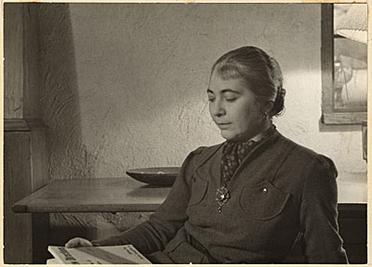
Edith Halpert: A Pioneering Dealer and Promoter of American Art
One example of her panache: just over 78 years ago, in December 1941, Edith Gregor Halpert had planned a gala opening for the Downtown Gallery’s landmark exhibition, “American Negro Art, 19th and 20th Centuries.” Eleanor Roosevelt, who had shopped at the Downtown Gallery and Mayor Fiorello H. Laguardia headed the Sponsorship Committee for the cocktail preview. Luminaries from entertainment including Katherine Dunham, W.C. Handy, Paul Robeson, William [Bill Bojangles] Robinson, and Ethel Walters, were joined by art patrons, intellectuals, and others. Josh White and other artists were to provide entertainment.
Working with Alain Locke, known as the “dean of the Harlem Renaissance,” Halpert assembled a strong group of 50 paintings, sculpture, and prints. She had already added Jacob Lawrence to the Downtown Gallery roster and arranged for a major portfolio from his “Migration of the Negro” series to appear in Fortune Magazine the previous month. Halpert had planned for other New York galleries to each add one of the other contemporary African-American artists to their roster.
Undoubtedly many potential participants and guests missed attending the gala and exhibition following the upheaval related to the surprise attack on Pearl Harbor, just the previous day.
the previous day.
Nevertheless she persisted.
And the exhibition remained significant to many artists such as Romare Bearden and Elizabeth Catlett, who had an opportunity to see their work at the Downtown Gallery. No other exhibition at that time had shown as many museum quality art works and included examples from both the nineteenth and twentieth centuries by African American artists.
By March, Halpert had negotiated the sale of the 30 odd numbered panels of Lawrence’s The Migration Series to Duncan Phillips, on behalf of the Phillips Collection, and the 30 even numbered panels to Adele Levy, on behalf of the Museum of Modern Art. In fact, the even-numbered panels can be seen in the renovated MOMA today, where they attract significant attention.
If you can’t personally get to New York’s Jewish Museum before the February 9, 2020 closing, examine the rich website “Edith Halpert and the Rise of American Art.” This digital version includes a summary text, selected images, an Audio Guide [with transcript], and stories focusing on Halpert’s dachshund, Adam, and more. See also Yale University Press‘s related 232 page, richly illustrated publication.



